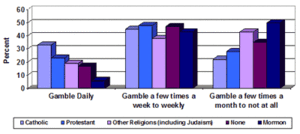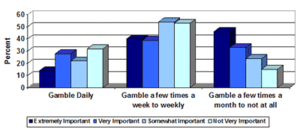The WAGER Vol. 7(41) – Gambling in Sin City: The Role of Religion
Past research has demonstrated that religiosity exerts a protective effect against substance use and abuse (Amoateng & Bahr, 1986; Kendler, Gardner, & Prescott, 1997; Miller, Davies, & Greenwald, 2000; Wallace & Bachman, 1991). In order to determine whether the same relationship exists between religion and gambling participation, Diaz (2000) conducted a telephone survey of 513 Las Vegas residents using random digit dialing. The survey consisted of questions regarding the participants’ gambling patterns and religious practices. This week’s WAGER presents the survey results.
Diaz found that almost a quarter of all Las Vegas residents surveyed gambled daily. As Figure 1 illustrates, gambling frequency was influenced by religious denomination (.2 = 23.1, df = 8, p<0.05). Most Protestant faiths (including Mormonism) actively discourage gambling, whereas Catholicism and Judaism do not denounce this behavior (Edmonson, 1986). Although residents who identified themselves as Catholic were most likely to gamble daily (33%), nearly a quarter of non-Mormon Protestants also gambled daily. Weekly gambling participation appeared more evenly distributed across religion; however, there seemed to be substantial variation among respondents who said they gambled infrequently or not at all, ranging from 22% of Catholics to 50% of Mormons; the obverse of the pattern observed for daily gambling.
Figure 1. Differences in Frequency of Gambling by Religious Denomination (Diaz, 2000)
Although the above results demonstrate a relationship between gambling and religious denomination, affiliation does not equate with religious involvement. To examine the effect of religious involvement, as opposed to religious affiliation, Diaz recorded respondents’ reports of the importance of religion in their life and respondents’ frequency of attendance at religious services. Those who attended services daily or several times a week were much less likely to report daily gambling (.2 = 38.82, df = 10, p<0.05). Religious importance was also inversely related to gambling; only 14% of residents who consider religion to be extremely important gambled daily compared to 32% of residents who ranked religion as not very important (Figure 2).
Figure 2. Differences in Frequency of Gambling by the Level of Importance of Religion in the Life of the Respondent (Diaz, 2000)
Although the results of this study point to a relationship between religiosity and gambling, it would be premature to conclude that religious involvement or affiliation causes a reduction in gambling participation; an underlying factor might mediate involvement in both these areas. It would not be unreasonable to believe that the same disposition that would lead a person to gamble regularly might also lead them to shun religious involvement. Further, this study did not collect information on features of each religion that might directly influence the gambling behavior of their members (e.g., active discouragement of gambling, or alternatively, hosting bingo games). It is also important to note that this study did not examine problem gambling: therefore, we cannot draw conclusions about whether involvement in a religious community protects against disordered gambling.
Nonetheless, religious factors that encourage gambling abstinence might aid in curtailing problem gambling as well as drug and alcohol use. Persons at high risk might benefit from the community interaction, support network, and/or moral guidance that can accompany religious involvement. If a causal relationship does exists, determining the underlying mechanisms by which religious affiliation and devotion affect gambling behavior might lead to a better understanding the social factors which protect against problem gambling.
Comments on this article can be addressed to Rachel Kidman.
References
Amoateng, A. Y., & Bahr, S. J. (1986). Religion, family, and adolescent drug abuse. Sociological Perspectives, 29(1), 53-76.
Diaz, J. (2000). Religion and gambling in sin-city: A statistical analysis of the relationship between religion and gambling patterns in Las Vegas residents. The Social Science Journal, 37(3), 453-458.
Edmonson, B. (1986). Demographics of gambling. American Demographics, 8(7), 105-110.
Kendler, K. S., Gardner, C. O., & Prescott, C. A. P. (1997). Religion, psychopathology, and substance use and abuse: A multimeasure, genetic-epidemiologic study. American Journal of Psychiatry., 154(3), 322
329.
Miller, L., Davies, M., & Greenwald, S. (2000). Religiosity and substance use and abuse among adolescents in the national comorbidity survey. Journal of the American Academy of Child & Adolescent Psychiatry., 39(9), 1190-1197.
Wallace, J. M., & Bachman, J. G. (1991). Explaining racial/ethnic differences in adolescent drug use: The impact of background and lifestyle. Social Problems., 38(3), 333-357.

